2016年新SAT阅读官方样题-深度解读
新sat官方指南阅读试题解析之文本细读题
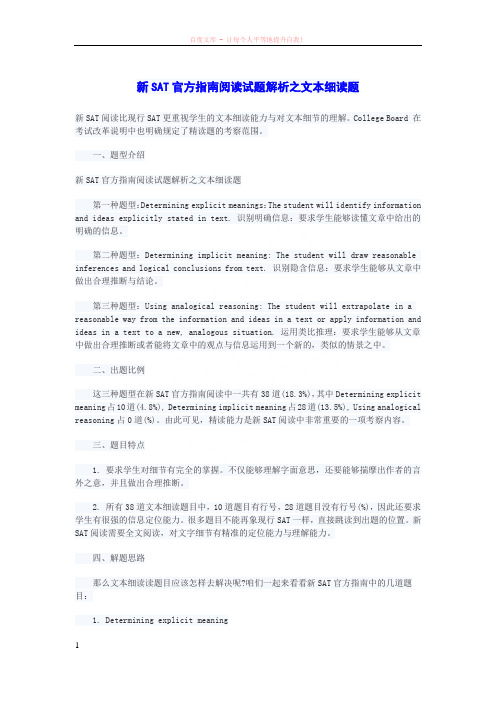
新SAT官方指南阅读试题解析之文本细读题新SAT阅读比现行SAT更重视学生的文本细读能力与对文本细节的理解。
College Board 在考试改革说明中也明确规定了精读题的考察范围。
一、题型介绍新SAT官方指南阅读试题解析之文本细读题第一种题型:Determining explicit meanings:The student will identify information and ideas explicitly stated in text. 识别明确信息:要求学生能够读懂文章中给出的明确的信息。
第二种题型:Determining implicit meaning: The student will draw reasonable inferences and logical conclusions from text. 识别隐含信息:要求学生能够从文章中做出合理推断与结论。
第三种题型:Using analogical reasoning: The student will extrapolate in a reasonable way from the information and ideas in a text or apply information and ideas in a text to a new, analogous situation. 运用类比推理:要求学生能够从文章中做出合理推断或者能将文章中的观点与信息运用到一个新的,类似的情景之中。
二、出题比例这三种题型在新SAT官方指南阅读中一共有38道(18.3%),其中Determining explicit meaning占10道(4.8%), Determining implicit meaning占28道(13.5%), Using analogical reasoning占0道(%)。
由此可见,精读能力是新SAT阅读中非常重要的一项考察内容。
2016sat改革语法官方样题详解二续
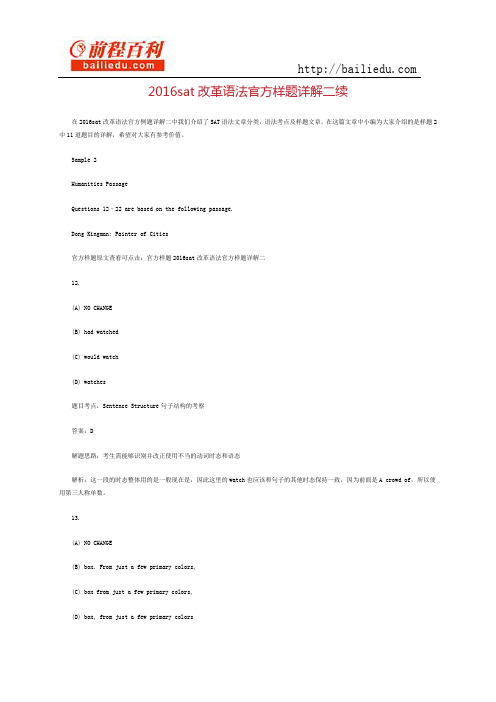
2016sat改革语法官方样题详解二续在2016sat改革语法官方例题详解二中我们介绍了SAT语法文章分类,语法考点及样题文章,在这篇文章中小编为大家介绍的是样题2中11道题目的详解,希望对大家有参考价值。
Sample 2Humanities PassageQuestions 12–22 are based on the following passage.Dong Kingman: Painter of Cities官方样题原文查看可点击:官方样题2016sat改革语法官方样题详解二12.(A) NO CHANGE(B) had watched(C) would watch(D) watches题目考点:Sentence Structure句子结构的考察答案:D解题思路:考生需能够识别并改正使用不当的动词时态和语态解析:这一段的时态整体用的是一般现在是,因此这里的watch也应该和句子的其他时态保持一致,因为前面是A crowd of,所以使用第三人称单数。
13.(A) NO CHANGE(B) box. From just a few primary colors,(C) box from just a few primary colors,(D) box, from just a few primary colors题目考点:Sentence Structure句子结构的考察答案:B解题思路:考生需要形成两个语法上完整标准的句子。
解析:A crowd of….. watercolor box.是一个完整的句子,而从from just开始是一个Kingman做主语的另外一个句子,所以中间要用句号隔开。
14.(A) NO CHANGE(B) parts: “king” and “man,”(C) parts “king” and “man”;(D) parts; “king” and “man”题目考点:Conventions of Punctuation标点符号的使用答案:B解题思路:考生需掌握句子中分级的关系的标点用法解析:B选项中parts后面使用的冒号,正确的表达了two parts和后面“king”和“man,”的关系,这两部分包括了king”和“man,”因此只有B选项中的冒号是最准确的表达。
无惧变革,独家解析新SAT官方样题
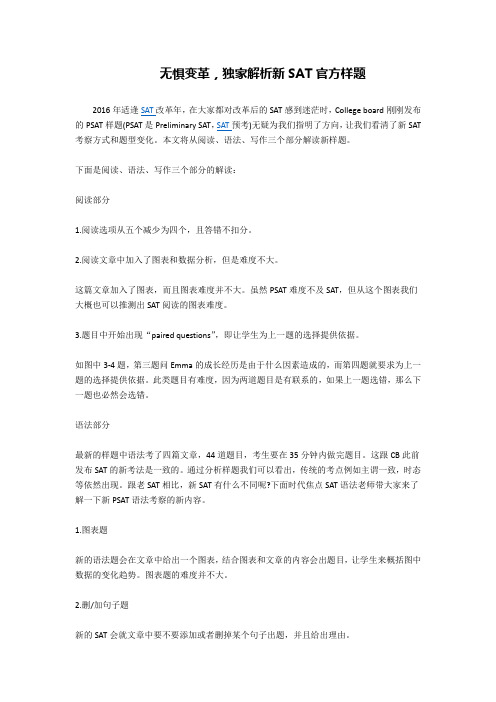
无惧变革,独家解析新SAT官方样题2016年适逢SAT改革年,在大家都对改革后的SAT感到迷茫时,College board刚刚发布的PSAT样题(PSAT是Preliminary SAT,SAT预考)无疑为我们指明了方向,让我们看清了新SAT 考察方式和题型变化。
本文将从阅读、语法、写作三个部分解读新样题。
下面是阅读、语法、写作三个部分的解读:阅读部分1.阅读选项从五个减少为四个,且答错不扣分。
2.阅读文章中加入了图表和数据分析,但是难度不大。
这篇文章加入了图表,而且图表难度并不大。
虽然PSAT难度不及SAT,但从这个图表我们大概也可以推测出SAT阅读的图表难度。
3.题目中开始出现“paired questions”,即让学生为上一题的选择提供依据。
如图中3-4题,第三题问Emma的成长经历是由于什么因素造成的,而第四题就要求为上一题的选择提供依据。
此类题目有难度,因为两道题目是有联系的,如果上一题选错,那么下一题也必然会选错。
语法部分最新的样题中语法考了四篇文章,44道题目,考生要在35分钟内做完题目。
这跟CB此前发布SAT的新考法是一致的。
通过分析样题我们可以看出,传统的考点例如主谓一致,时态等依然出现。
跟老SAT相比,新SAT有什么不同呢?下面时代焦点SAT语法老师带大家来了解一下新PSAT语法考察的新内容。
1.图表题新的语法题会在文章中给出一个图表,结合图表和文章的内容会出题目,让学生来概括图中数据的变化趋势。
图表题的难度并不大。
2.删/加句子题新的SAT会就文章中要不要添加或者删掉某个句子出题,并且给出理由。
综上,新SAT语法会更多地考察考生对于段落修辞甚至整篇文章脉络的把握,所以学生在备考的时候除了要备考传统的句法词法知识点之外,还要多注意分析文章的结构。
写作部分作文部分(Essay)是2016年SAT改革中变化最大的部分。
新SAT的写作部分要求学生先读一篇文章,然后对文章的内容以及表达方式进行评论。
新SAT阅读题型解析
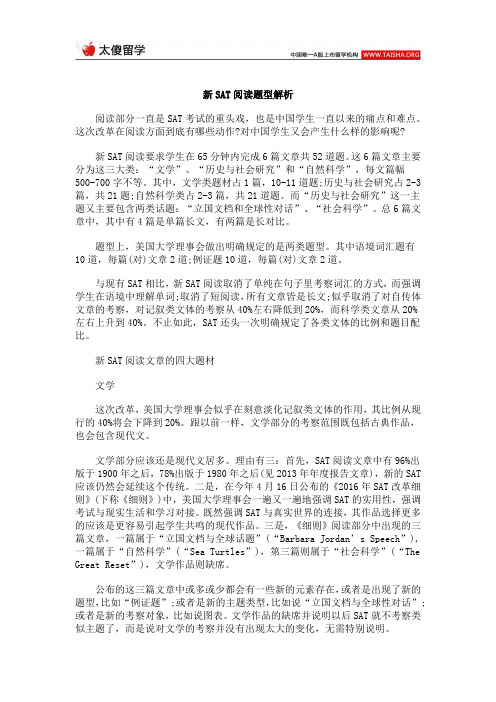
新SAT阅读题型解析阅读部分一直是SAT考试的重头戏,也是中国学生一直以来的痛点和难点。
这次改革在阅读方面到底有哪些动作?对中国学生又会产生什么样的影响呢?新SAT阅读要求学生在65分钟内完成6篇文章共52道题。
这6篇文章主要分为这三大类:“文学”、“历史与社会研究”和“自然科学”,每文篇幅500-700字不等。
其中,文学类题材占1篇,10-11道题;历史与社会研究占2-3篇,共21题;自然科学类占2-3篇,共21道题。
而“历史与社会研究”这一主题又主要包含两类话题:“立国文档和全球性对话”、“社会科学”。
总6篇文章中,其中有4篇是单篇长文,有两篇是长对比。
题型上,美国大学理事会做出明确规定的是两类题型。
其中语境词汇题有10道,每篇(对)文章2道;例证题10道,每篇(对)文章2道。
与现有SAT相比,新SAT阅读取消了单纯在句子里考察词汇的方式,而强调学生在语境中理解单词;取消了短阅读,所有文章皆是长文;似乎取消了对自传体文章的考察,对记叙类文体的考察从40%左右降低到20%,而科学类文章从20%左右上升到40%。
不止如此,SAT还头一次明确规定了各类文体的比例和题目配比。
新SAT阅读文章的四大题材文学这次改革,美国大学理事会似乎在刻意淡化记叙类文体的作用,其比例从现行的40%将会下降到20%。
跟以前一样,文学部分的考察范围既包括古典作品,也会包含现代文。
文学部分应该还是现代文居多。
理由有三:首先,SAT阅读文章中有96%出版于1900年之后,78%出版于1980年之后(见2013年年度报告文章),新的SAT 应该仍然会延续这个传统。
二是,在今年4月16日公布的《2016年SAT改革细则》(下称《细则》)中,美国大学理事会一遍又一遍地强调SAT的实用性,强调考试与现实生活和学习对接。
既然强调SAT与真实世界的连接,其作品选择更多的应该是更容易引起学生共鸣的现代作品。
三是,《细则》阅读部分中出现的三篇文章,一篇属于“立国文档与全球话题”(“Barbara Jordan’s Speech”), 一篇属于“自然科学”(“Sea Turtles”),第三篇则属于“社会科学”(“The Great Reset”),文学作品则缺席。
OG新SAT考试详细解读 16年SAT考试有救了!
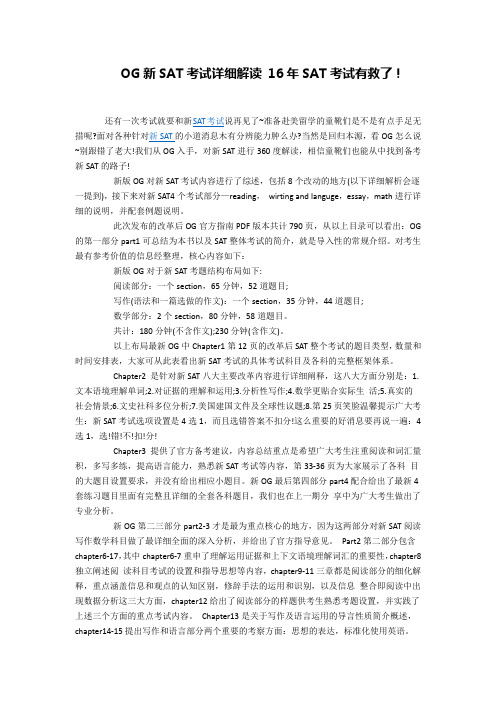
OG新SAT考试详细解读16年SAT考试有救了!还有一次考试就要和新SAT考试说再见了~准备赴美留学的童靴们是不是有点手足无措呢?面对各种针对新SAT的小道消息木有分辨能力肿么办?当然是回归本源,看OG怎么说~别跟错了老大!我们从OG入手,对新SAT进行360度解读,相信童靴们也能从中找到备考新SAT的路子!新版OG对新SAT考试内容进行了综述,包括8个改动的地方(以下详细解析会逐一提到),接下来对新SAT4个考试部分—reading,wirting and languge,essay,math进行详细的说明,并配套例题说明。
此次发布的改革后OG官方指南PDF版本共计790页,从以上目录可以看出:OG 的第一部分part1可总结为本书以及SAT整体考试的简介,就是导入性的常规介绍。
对考生最有参考价值的信息经整理,核心内容如下:新版OG对于新SAT考题结构布局如下:阅读部分:一个section,65分钟,52道题目;写作(语法和一篇选做的作文):一个section,35分钟,44道题目;数学部分:2个section,80分钟,58道题目。
共计:180分钟(不含作文);230分钟(含作文)。
以上布局最新OG中Chapter1第12页的改革后SAT整个考试的题目类型,数量和时间安排表,大家可从此表看出新SAT考试的具体考试科目及各科的完整框架体系。
Chapter2 是针对新SAT八大主要改革内容进行详细阐释,这八大方面分别是:1.文本语境理解单词;2.对证据的理解和运用;3.分析性写作;4.数学更贴合实际生活;5.真实的社会情景;6.文史社科多位分析;7.美国建国文件及全球性议题;8.第25页笑脸温馨提示广大考生:新SAT考试选项设置是4选1,而且选错答案不扣分!这么重要的好消息要再说一遍:4选1,选!错!不!扣!分!Chapter3 提供了官方备考建议,内容总结重点是希望广大考生注重阅读和词汇量积,多写多练,提高语言能力,熟悉新SAT考试等内容,第33-36页为大家展示了各科目的大题目设置要求,并没有给出相应小题目。
2016年新SAT Essay要点剖析
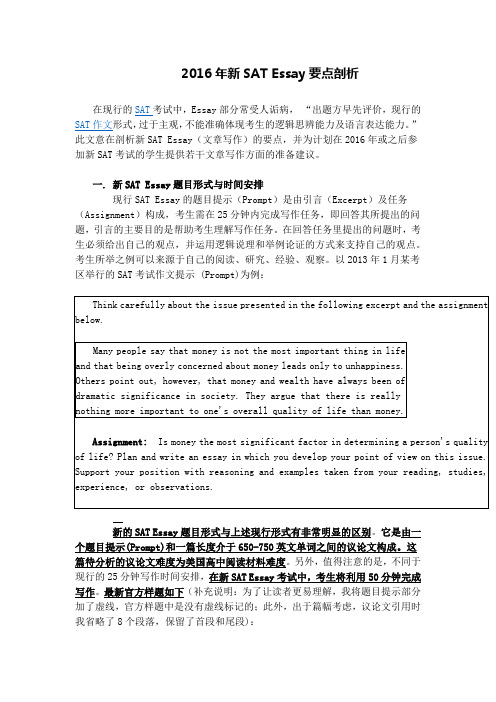
As you read the passage below, consider how Dana Gioia uses• evidence, such as facts or examples, to support claims.• reasoning to develop ideas and to connect claims and evidence.• stylistic or persuasive elements, such as word choice or appeals to emotion, to add power to the ideas expressed.Adapted from “Why Literature Matters”by Dana Gioia. ©2005 by The New York Times Company. Originally published April 10, 2005.[A] strange thing has happened in the American arts during the past quarter century. While income rose to unforeseen levels, college attendance ballooned, and access to information increased enormously, the interest young Americans showed in the arts—and especially literature —actually diminished.…(出于篇幅考虑,此处省略8个段落)Reading is not a timeless, universal capability. Advanced literacy is a specific intellectual skill and social habit that depends on a great many educational, cultural, and economic factors. As more Americans lose this capability, our nation becomes less informed, active, and independent-minded. These are not the qualities that a free, innovative, or productive society can afford to lose.Write an essay in which you explain how Dana Gioia builds an argument to persuade his audience that the decline of reading in America will have a negative effect on society. In your essay, analyze how Gioia uses one or more of the features listed in the box above (or features of your own choice) to strengthen the logic and persuasiveness of his argument. Be sure that your analysis focuses on the most relevant features of the passage.Your essay should not explain whether you agree with Gioia’s claims, but rather explain how Gioia builds an argument to persuade his audience.从上述样题的粗体字部分可以看出,这篇需要分析的样文最初发表于2005年4月,其标题为《文学为何重要》(“Why Literature Matters”)。
三月北美新SAT阅读首考报告 真题还原分析及权威复习资料推荐
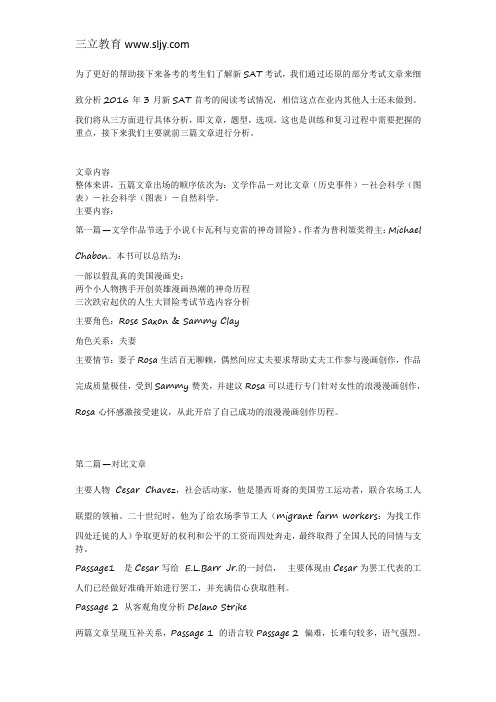
为了更好的帮助接下来备考的考生们了解新SAT考试,我们通过还原的部分考试文章来细致分析2016年3月新SAT首考的阅读考试情况,相信这点在业内其他人士还未做到。
我们将从三方面进行具体分析,即文章,题型,选项,这也是训练和复习过程中需要把握的重点,接下来我们主要就前三篇文章进行分析。
文章内容整体来讲,五篇文章出场的顺序依次为:文学作品-对比文章(历史事件)-社会科学(图表)-社会科学(图表)-自然科学。
主要内容:第一篇—文学作品节选于小说《卡瓦利与克雷的神奇冒险》,作者为普利策奖得主:Michael Chabon。
本书可以总结为:一部以假乱真的美国漫画史;两个小人物携手开创英雄漫画热潮的神奇历程三次跌宕起伏的人生大冒险考试节选内容分析主要角色:Rose Saxon & Sammy Clay角色关系:夫妻主要情节:妻子Rosa生活百无聊赖,偶然间应丈夫要求帮助丈夫工作参与漫画创作,作品完成质量极佳,受到Sammy赞美,并建议Rosa可以进行专门针对女性的浪漫漫画创作,Rosa心怀感激接受建议,从此开启了自己成功的浪漫漫画创作历程。
第二篇—对比文章主要人物Cesar Chavez,社会活动家,他是墨西哥裔的美国劳工运动者,联合农场工人联盟的领袖。
二十世纪时,他为了给农场季节工人(migrant farm workers:为找工作四处迁徙的人)争取更好的权利和公平的工资而四处奔走,最终取得了全国人民的同情与支持。
Passage1 是Cesar写给E.L.Barr Jr.的一封信,主要体现由Cesar为罢工代表的工人们已经做好准确开始进行罢工,并充满信心获取胜利。
Passage 2 从客观角度分析Delano Strike两篇文章呈现互补关系,Passage 1 的语言较Passage 2 偏难,长难句较多,语气强烈。
第三篇—社会科学文章写作思路清晰,整体难度较低,主要探讨大脑发育与婴儿脂肪含量的关系,给出了不同的可能性解释。
2016年SAT改革之新样题解读
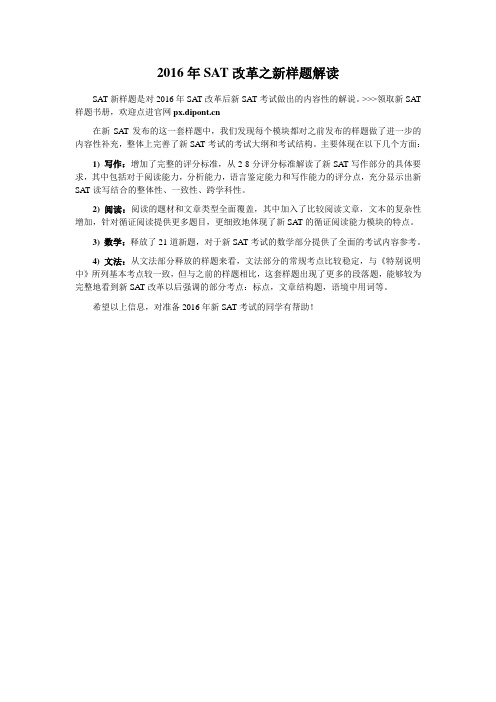
2016年SAT改革之新样题解读
SAT新样题是对2016年SAT改革后新SAT考试做出的内容性的解说。
>>>领取新SAT 样题书册,欢迎点进官网
在新SAT发布的这一套样题中,我们发现每个模块都对之前发布的样题做了进一步的内容性补充,整体上完善了新SA T考试的考试大纲和考试结构。
主要体现在以下几个方面:
1) 写作:增加了完整的评分标准,从2-8分评分标准解读了新SAT写作部分的具体要求,其中包括对于阅读能力,分析能力,语言鉴定能力和写作能力的评分点,充分显示出新SAT读写结合的整体性、一致性、跨学科性。
2) 阅读:阅读的题材和文章类型全面覆盖,其中加入了比较阅读文章,文本的复杂性增加,针对循证阅读提供更多题目,更细致地体现了新SA T的循证阅读能力模块的特点。
3) 数学:释放了21道新题,对于新SAT考试的数学部分提供了全面的考试内容参考。
4) 文法:从文法部分释放的样题来看,文法部分的常规考点比较稳定,与《特别说明中》所列基本考点较一致,但与之前的样题相比,这套样题出现了更多的段落题,能够较为完整地看到新SAT改革以后强调的部分考点:标点,文章结构题,语境中用词等。
希望以上信息,对准备2016年新SAT考试的同学有帮助!。
2016年新SAT样题——Writing and Language部分

2016年新SAT样题——Writing and Language部分2016年新SAT样题——Writing and Language部分Questions 1-7 are based on the following passage.Dong Kingman: Painter of CitiesA 1954 documentary about renowned watercolor painter Dong Kingman shows the artist sitting on a stool on Mott Street in New York City’s Chinatown. A crowd of admiring spectators watches as Kingman squeezes dollops of paint from several tubes into a tin watercolor ①box, from just a few primary colors, Kingman creates dozens of beautiful hues as he layers the translucent paint onto the paper on his easel. Each stroke of the brush and dab of the sponge transforms thinly sketched outlines into buildings, shop signs, and streetlamps. The street scene Kingman begins composing in this short film is very much in keeping with the urban landscapes for which he is best known.[1] Kingman was keenly interested in landscape painting from an early age. [2] In Hong Kong, where Kingman completed his schooling, teachers at that time customarily assigned students a formal “school name.” [3] His interest was so keen, in fact, that he was named after it. [4] The young boy who had been called Dong Moy Shu became Dong Kingman.[5] The name Kingman was selected for its two ②parts, “king” and “man”; Cantonese for “scenery” and “composition.” [6] As Kingman developed as a painter, his works were often compared to ③paintings by Chinese landscape artists dating back to CE 960, a time when a strong tradition of landscape painting emerged in Chinese art. [7] Kingman, however, ④vacated from that tradition in a number of ways, most notably in that he chose to focus not on natural landscapes, such as mountains and rivers, but on cities.⑤⑥His fine brushwork conveys detailed street-level activity: a peanut vendor pushing his cart on the sidewalk, a pigeon pecking for crumbs around a fire hydrant, an old man tending to a baby outside a doorway. His broader brushstrokes and sponge-painted shapes create majestic city skylines, with skyscrapers towering in the background, bridges connecting neighborhoods on either side of a river, and enormous ships maneuvering out of a busy harbor. To art critics and fans alike, these city scenes represent the innovative spirit of twentieth-century urban Modernism.During his career, Kingman exhibited his work ⑦internationally. He garnered much acclaim. In 1936, a critic described one of Kingman’s solo exhibits as “twenty of the freshest, most satisfying watercolors that have been seen hereabouts in many a day.” Si nce Kingman’s death in 2000, museums across the United States and in China have continued to ensure that his now-iconic landscapes remain available for the public to enjoy.1.(A) NO CHANGE(B) box. From just a few primary colors(C) box from just a few primary colors(D) box, from just a few primary colors2.(A) NO CHANGE(B) parts: “king” and “man,”(C) parts “king” and “man”;(D) parts; “king” and “man”3.(A) NO CHANGE(B) Chinese landscape artists(C) painters of Chinese landscapes(D) artists4.(A) NO CHANGE(B) evacuated(C) departed(D) retired5. For the sake of the cohesion of this paragraph, sentence 3 should be placed(A) where it is now.(B) before sentence 1.(C) after sentence 1.(D) after sentence 4.6. Which choice most effectively establishes the main topic of the paragraph?(A) Kingman is considered a pioneer of the California Style school of painting.(B) Although cities were his main subject, Kingman did occasionally paint natural landscapes.(C) In his urban landscapes, Kingman captures the vibrancy of crowded cities.(D) In 1929 Kingman moved to Oakland, California, where he attended the Fox Art School.7. Which choice most effectively combines the sentences at the underlined portion?(A) internationally, and Kingman also garnered(B) internationally; from exhibiting, he garnered(C) internationally but garnered(D) internationally, garneringQuestions 8-13 are based on the following passage and supplementary material.A Life in TrafficA subway system is expanded to provide service to a growing suburb.A bike-sharing program is adopted to encourage nonmotorized transportation. Stoplight timing is coordinated to alleviate rush hour traffic jams in a congested downtown area. When any one of these changes ⑧occur, it is likely the result of careful analysis conducted by transportation planners.The work of transportation planners generally includes evaluating current transportation needs, assessing the effectiveness of existing facilities, and improving those facilities or ⑨they design new ones. Most transportation planners work in or near cities, but some are employed in rural areas. Say, for example, a large factory is built on the outskirts of a small town. Traffic to and from that location would increase at the beginning and end of work shifts. The transportation planner’s job might involve conducting a traffic count to determine the daily number of vehicles traveling on the road to the new factory. If analysis of the traffic count indicates that there is more traffic than the ⑩current road as it is designed at this time can efficiently accommodate, the transportation planner might recommend widening the road to add another lane.Transportation planners work closely with a number of community stakeholders, such as government officials and other interested organizations and individuals. ?Next, representatives from the local public health department might provide input in designing a network oftrails and sidewalks to encourage people to walk more. Members of the Chamber of Commerce might share suggestions about designing transportation and parking facilities to support local businesses.?People who pursue careers in transportation planning have a wide variety of educational backgrounds. A two-year degree in transportation technology may be sufficient for some entry-level jobs in the field. Most jobs, however, require at least a bachelor’s degree; majors of transportation planners are varied, including fields such as urban studies, civil engineering, geography, or transportation and logistics management. For many positions in the field, a master’s degree is required.Transportation planners perform critical work within the broader field of urban and regional planning. As of 2010, there were approximately 40,300 urban and regional planners employed in the United States. The United States Bureau of Labor Statistics forecasts steady job growth in this field, ?projecting that 16 percent of new jobs in all occupations will be related to urban and regional planning. Population growth and concerns about environmental sustainability are expected to spur the need for transportation planning professionals.扫描二维码限时获取免费视频课程。
2016新SAT第一份样卷第三篇阅读翻译
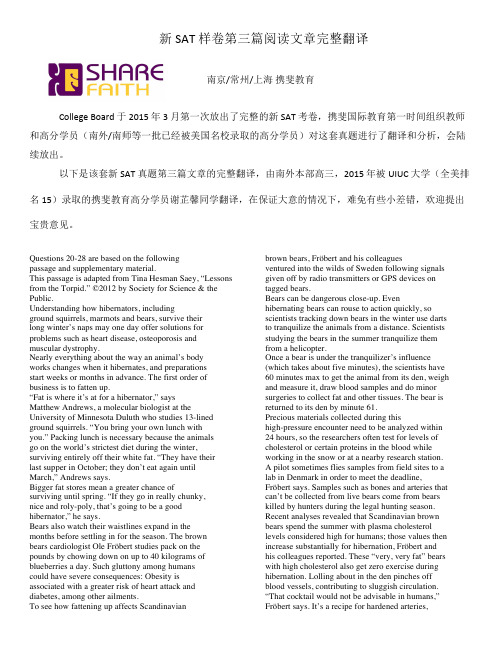
新SAT样卷第三篇阅读文章完整翻译南京/常州/上海 携斐教育College B oard于2015年3月第一次放出了完整的新SAT考卷,携斐国际教育第一时间组织教师和高分学员(南外/南师等一批已经被美国名校录取的高分学员)对这套真题进行了翻译和分析,会陆续放出。
以下是该套新SAT真题第三篇文章的完整翻译,由南外本部高三,2015年被UIUC大学(全美排名15)录取的携斐教育高分学员谢芷馨同学翻译,在保证大意的情况下,难免有些小差错,欢迎提出宝贵意见。
Questions 20-28 are based on the followingpassage and supplementary material.This passage is adapted from Tina Hesman Saey, “Lessons from the Torpid.” ©2012 by Society for Science & the Public.Understanding how hibernators, includingground squirrels, marmots and bears, survive theirlong winter’s naps may one day offer solutions for problems such as heart disease, osteoporosis and muscular dystrophy.Nearly everything about the way an animal’s bodyworks changes when it hibernates, and preparationsstart weeks or months in advance. The first order of business is to fatten up.“Fat is where it’s at for a hibernator,” saysMatthew Andrews, a molecular biologist at the University of Minnesota Duluth who studies 13-lined ground squirrels. “You bring your own lunch with you.” Packing lunch is necessary because the animalsgo on the world’s strictest diet during the winter, surviving entirely off their white fat. “They have their last supper in October; they don’t eat again until March,” Andrews says.Bigger fat stores mean a greater chance ofsurviving until spring. “If they go in really chunky,nice and roly-poly, that’s going to be a good hibernator,” he says.Bears also watch their waistlines expand in themonths before settling in for the season. The brown bears cardiologist Ole Fröbert studies pack on the pounds by chowing down on up to 40 kilograms of blueberries a day. Such gluttony among humanscould have severe consequences: Obesity isassociated with a greater risk of heart attack and diabetes, among other ailments.To see how fattening up affects Scandinavian brown bears, Fröbert and his colleaguesventured into the wilds of Sweden following signals given off by radio transmitters or GPS devices on tagged bears.Bears can be dangerous close-up. Even hibernating bears can rouse to action quickly, so scientists tracking down bears in the winter use darts to tranquilize the animals from a distance. Scientists studying the bears in the summer tranquilize them from a helicopter.Once a bear is under the tranquilizer’s influence (which takes about five minutes), the scientists have 60 minutes max to get the animal from its den, weigh and measure it, draw blood samples and do minor surgeries to collect fat and other tissues. The bear is returned to its den by minute 61.Precious materials collected during thishigh-pressure encounter need to be analyzed within 24 hours, so the researchers often test for levels of cholesterol or certain proteins in the blood while working in the snow or at a nearby research station.A pilot sometimes flies samples from field sites to a lab in Denmark in order to meet the deadline,Fröbert says. Samples such as bones and arteries that can’t be collected from live bears come from bears killed by hunters during the legal hunting season. Recent analyses revealed that Scandinavian brown bears spend the summer with plasma cholesterol levels considered high for humans; those values then increase substantially for hibernation, Fröbert and his colleagues reported. These “very, very fat” bears with high cholesterol also get zero exercise during hibernation. Lolling about in the den pinches off blood vessels, contributing to sluggish circulation. “That cocktail would not be advisable in humans,”Fröbert says. It’s a recipe for hardened arteries,putting people at risk for heart attacks and strokes. Even healthy young adult humans can developfatty streaks in their arteries that make the blood vessels less flexible, but the bears don’t build up such artery-hardening streaks. “Our bears, they had nothing,” Fröbert says. It’s not yet clear how the bears keep their arteries flexible, but Fröbert hopes to find some protective molecule that could stave off hardened arteries in humans as well.20. The passage is written from the perspective ofsomeone who isA) actively involved in conducting hibernator research.B) a participant in a recent debate in the field of cardiology.C) knowledgeable about advances in hibernator research.D) an advocate for wildlife preservation.21. It is reasonable to conclude that the main goal of the scientists conducting the research described in the passage is toA) learn how the hibernation patterns of bears and squirrels differ.B) determine the role that fat plays in hibernation.C) illustrate the important health benefits ofexercise for humans.D) explore possible ways to prevent human diseases.22. Which choice provides the best evidence for the answer to the previous question?A) Lines 1-5 (“Understanding . . . dystrophy”)B) Lines 10-13 (“Fat . . . squirrels”)C) Lines 31-35 (“To . . . bears”)D) Lines 42-46 (“Once . . . tissues”)23.What main effect do the quotations by Andrews in lines 10-18 have on the tone of the passage?A) They create a bleak tone, focusing on the difficulties hibernators face during the winter.B) They create a conversational tone, relating scientific information in everyday language.C) They create an ominous tone, foreshadowing the dire results of Andrews’s research.D) They create an absurd tone, using images of animals acting as if they were human.24. As used in line 19, “stores” most nearly meansA) preservatives.B) reserves.C) stacks.D) shelters. 25. Based on the passage, what is Fröbert’s hypothesis regarding why bears’ arteries do not harden during hibernation?A) The bears’ increased plasma cholesterol causes the arteries to be more flexible.B) Sluggish circulation pinches off the blood vessels rather than hardening the arteries.C) Bears exercise in short, infrequent bursts during hibernation, which staves off hardened arteries.D) Bears possess a molecule that protects against hardened arteries.26.Which choice provides the best evidence for the answer to the previous question?A) Lines 19-20 (“Bigger . . . spring”)B) Lines 24-27 (“The brown . . . day”)C) Lines 69-72 (“Even . . . streaks”)D) Lines 73-76 (“It’s . . . well”)27.What information discussed in paragraph 10 (lines 58-68) is represented by the graph?A) The information in lines 58-62 (“Recent . . . reported”)B) The information in lines 62-64 (“These . . . hibernation”)C) The information in lines 64-65 (“Lolling . . . circulation”)D) The information in lines 67-68 (“It’s . . . strokes”)28. Which statement about the effect of hibernation on the seven bears is best supported by the graph?A) Only one of the bears did not experience an appreciable change in its total plasma cholesterol level.B) Only one of the bears experienced a significant increase in its total plasma cholesterol level.C) All of the bears achieved the desirable plasma cholesterol level for humans.D) The bear with the lowest total plasma cholesterol level in its active state had the highest totalplasma cholesterol level during hibernation.对于像松鼠,土拔鼠和熊这样的冬眠动物是如何度过他们漫长的冬眠的了解,或许有一天会为像心脏病,骨质疏松和肌肉萎缩症等问题提供解决方案。
2016年10月1日新SAT回顾及答案
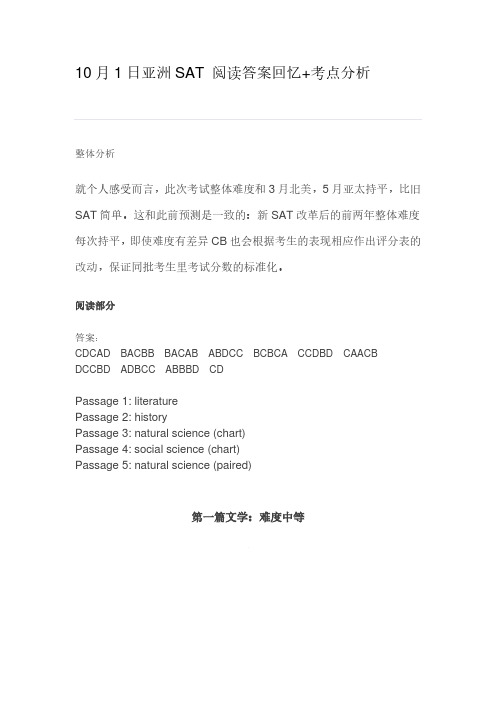
10月1日亚洲SAT 阅读答案回忆+考点分析整体分析就个人感受而言,此次考试整体难度和3月北美,5月亚太持平,比旧SAT简单。
这和此前预测是一致的:新SAT改革后的前两年整体难度每次持平,即使难度有差异CB也会根据考生的表现相应作出评分表的改动,保证同批考生里考试分数的标准化。
阅读部分答案:CDCAD BACBB BACAB ABDCC BCBCA CCDBD CAACB DCCBD ADBCC ABBBD CDPassage 1: literaturePassage 2: historyPassage 3: natural science (chart)Passage 4: social science (chart)Passage 5: natural science (paired)第一篇文学:难度中等文章大意:讲一个女的在别人家当governess,孩子叫Adele,孩子很乖,家长也挺好。
但是narrator就是对现状不满,想要探索更多外面的世界。
难度分析:文字难度一般,比OG1的Akira难,和OG2的the professor 难度差不多。
但是小说一般都单词难,这次也不例外,像原文的prattle,选项的surreal相信很多学生都不清楚意思。
题目还原:1. 主旨题:应选the narrator reflects her feelings。
2 .and3. 询证题:问the narrator怎么看她的学生Adele,应选unremarkable,对应原文的not the greatest, nor deficient。
match4.目的题/观点题:问simplicity and prattle的意义,应选particular endearing。
5 and 6. 询证题:问作者对于自己herself的看法,应选unbiased,对应原文的I’m merely telling the truth7. 主旨题/观点题:题目match答案暂保密。
新SAT阅读考点解析(2016年5月7日)
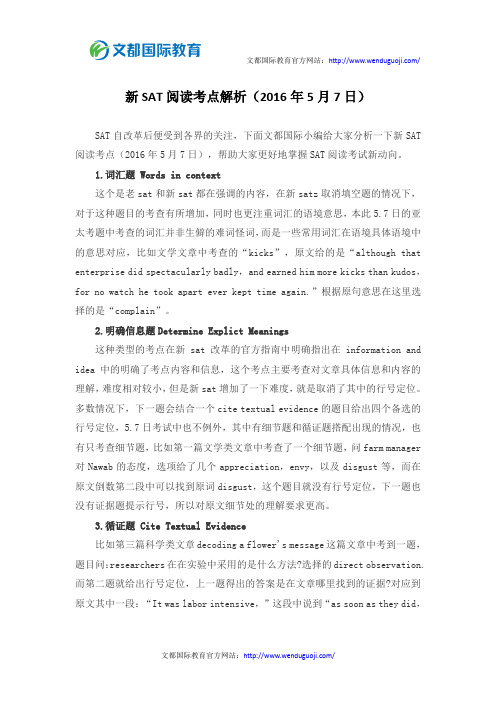
新SAT阅读考点解析(2016年5月7日)SAT自改革后便受到各界的关注,下面文都国际小编给大家分析一下新SAT 阅读考点(2016年5月7日),帮助大家更好地掌握SAT阅读考试新动向。
1.词汇题 Words in context这个是老sat和新sat都在强调的内容,在新satz取消填空题的情况下,对于这种题目的考查有所增加,同时也更注重词汇的语境意思,本此5.7日的亚太考题中考查的词汇并非生僻的难词怪词,而是一些常用词汇在语境具体语境中的意思对应,比如文学文章中考查的“kicks”,原文给的是“although that enterprise did spectacularly badly,and earned him more kicks than kudos,for no watch he took apart ever kept time again.”根据原句意思在这里选择的是“complain”。
2.明确信息题Determine Explict Meanings这种类型的考点在新sat改革的官方指南中明确指出在information and idea中的明确了考点内容和信息,这个考点主要考查对文章具体信息和内容的理解,难度相对较小,但是新sat增加了一下难度,就是取消了其中的行号定位。
多数情况下,下一题会结合一个cite textual evidence的题目给出四个备选的行号定位,5.7日考试中也不例外,其中有细节题和循证题搭配出现的情况,也有只考查细节题,比如第一篇文学类文章中考查了一个细节题,问farm manager 对Nawab的态度,选项给了几个appreciation,envy,以及disgust等,而在原文倒数第二段中可以找到原词disgust,这个题目就没有行号定位,下一题也没有证据题提示行号,所以对原文细节处的理解要求更高。
3.循证题 Cite Textual Evidence比如第三篇科学类文章decoding a flower's message这篇文章中考到一题,题目问:researchers在在实验中采用的是什么方法?选择的direct observation.而第二题就给出行号定位,上一题得出的答案是在文章哪里找到的证据?对应到原文其中一段:“It was labor intensive,”这段中说到“as soon as they did,the team spent the next several hours walking from flower to flower,observing each for two-minute intervals”.4.图表题 Analyze Quantative Information这个考点在5.7日考试中的社科文章以及科学文章中都有涉及,这个部分的考题相对于OG中的图表题目相对较难一些,图表也比较复杂,在public trust in the news这篇文章中的表格给的是几个不同年份下的公众对于新闻的看法,其中对于news organization 的看法认为其是independent的有多少人,认为她们的信息受expert观点的影响有偏见的有多少,don't know的人有多少。
2016年10月北美新SAT真题(附参考答案)_无水印高清哦
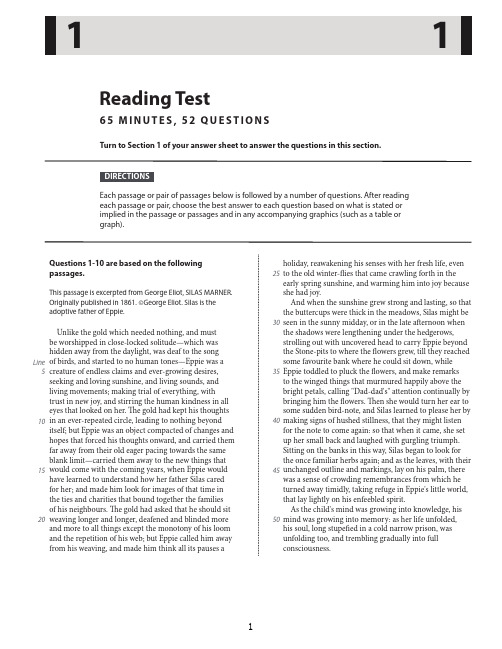
11SAT小帮手原创题目,版权所有,请勿盗用或者去掉我们的水印!去掉我们的水印这样很不尊重人你知道吗!12Which choice best describes a major theme of thepassage?A) The corrupting influence of a materialistic society.B) The moral purity of young children.C) The bittersweet brevity of childhood naiveté.D) The restorative power of parental love.As compared with Silas’s gold, Eppie is portrayed ashaving moreA) vitality.B) durability.C) protection.D) Self-sufficiency.34Which statement best describes a technique thatnarrator uses to represent Silas’s character before headopted Eppie?A) The narrator emphasizes Sila’s former obsessionwith wealth by depicting his gold as requiringcertain behaviors on his part.B) The narrator underscores Sila’s former greed bydescribing his gold as seeming to reproduce onits own.C) The narrator hints at Sila’s former antitheticalattitude by contrasting his present behaviortoward his neighbors with his past behaviortoward them.D) The narrator demonstrates Sila’s former lack ofself-awareness by implying that he is unable torecall life before Eppie.Th e narrator uses the phrase “making trial ofeverything” (line 7) to present Eppie asA) friendly.B) curious.C) disobedient.D) judgmental.5According to the narrator, one consequence of Silasadopting Eppie is that heA) has renounced all desire for moneyB) better understands his place in nature.C) seems more accepting of help from others.D) looks forward to a different kind of future.116Which choice provides the best evidence for theanswer to the previous question?A) lines 9-11 (“The ... itself”)B) lines 11-15 (“but ... years”)C) lines 38-40 (“Then ... stillness,”)D) lines 56-59 (“shapes ... for”)78What function does the second paragraph (lines 28-48) serve in the passage as a whole?A) It presents the particular moment at which Silasrecalled that Eppie was changing him.B) It highlights Silas’s love for Eppie by depictingthe sacrifices that he makes for her.C) It illustrates the effect that Eppie have on Silas bydescribing the interaction between them.D) It reveals a significant alteration in therelationship between Silas and Eppie.In describing the relationship between Eppie andSilas, the narrator draws a connection betweenEppie’sA) physical vulnerability and Silas’s emotionalfragility.B) expanding awareness and Silas’s increasingengagement with life.C) boundless energy and Silas’s insatiable desire forwealth.D) physical growth and Silas’s painful perception ofhis own mortality.9Which choice provides the best evidence for theanswer to the previous question?A) lines 1-9 (“Unlike ... her.”)B) lines 28-35 (“And ... fl owers”)C) lines 43-44 (“Sitting ... again”)D) lines 49-53 (“As ... consciousness”)10As used in line 60, “fine” most nearly meansA) acceptable.B) delicate.C) ornate.D) keen.SAT 小帮手原创题目,版权所有,请勿盗用或者去掉我们的水印!Questions 11-21 are based on the following passages.This passage is adapted from David Rotman, “HowTechnology is Destroying Jobs.” ©2013 by MIT Technology Review.MIT business scholars Erik Brynjolfsson andAndrew McAfee have argued that impressive advances in computer technology—from improved industrial robotics to automated translation services—are largely behind the sluggish employment growth of the last 10 to 15 years. Even more ominous for workers, they foresee dismal prospects for many types of jobs as these powerful new technologies are increasingly adopted not only in manufacturing, clerical, and retail work but in professions such as law, fi nancial services, education, and medicine. Th at robots, automation, and so ft ware can replace people might seem obvious to anyone who’s worked in automotive manufacturing or as a travel agent. But Brynjolfsson and McAfee’s claim is more troubling and controversial. Th ey believe that rapid technologicalchange has been destroying jobs faster than it is creating them, contributing to the stagnation of median income and the growth of inequality in the United States. And, they suspect, something similar is happening in other technologically advanced countries.As evidence, Brynjolfsson and McAfee point to a chart that only an economist could love. In economics, productivity—the amount of economic value created for a given unit of input, such as an hour of labor—is a crucial indicator of growth and wealth creation. It is a measure of progress. On the chart Brynjolfsson likes to show, separate lines represent productivity and total employment in the United States. For years a ft er World War II, the two lines closely tracked each other, with increases in jobs corresponding to increases inproductivity. Th e pattern is clear: as businesses generated more value from their workers, the country as a whole became richer, which fueled more economic activity and created even more jobs. Th en, beginning in 2000, the lines diverge; productivity continues to rise robustly, but employment suddenly wilts. By 2011, a signi fi cant gap appears between the two lines, showing economic growth with no parallel increase in job creation. Brynjolfsson and McAfee call it the “great decoupling.” And BrynjolfssonLine 510152025303540455055606570758085says he is con fi dent that technology is behind both thehealthy growth in productivity and the weak growth in jobs.It’s a startling assertion because it threatens the faith that many economists place in technological progress. Brynjolfsson and McAfee still believe that technology boosts productivity and makes societies wealthier, but they think that it can also have a dark side: technological progress is eliminating the need for many types of jobs and leaving the typical worker worse o ff than before. Brynjolfsson can point to a second chart indicating that median income is failing to rise even as the gross domestic product soars. “It’s the great paradox of our era,” he says. “Productivity is at record levels, innovation has never been faster, and yet at the same time, we have a falling median income and we have fewer jobs. People are falling behind because technology is advancing so fast and our skills and organizations aren’t keeping up.” While such technological changes can be painful for workers whose skills no longer match the needs of employers, Lawrence Katz, a Harvard economist, says that no historical pattern shows these shi ft s leading to a net decrease in jobs over an extended period. Katz has done extensive research on how technological advances have a ff ected jobs over the last few centuries—describing, for example, how highly skilled artisans in the mid-19th century were displaced by lower-skilled workers in factories. While it can take decades for workers to acquire the expertise needed for new types of employment, he says, “we never have run out of jobs. Th ere is no long-term trend of eliminating work for people. Over the long term, employment rates are fairly stable. People have always been able to create new jobs. People come up with new things to do.”Still, Katz doesn’t dismiss the notion that there is something di ff erent about today’s digital technologies—something that could a ff ect an even broader range of work. Th e question, he says, is whether economic history will serve as a useful guide. Will the job disruptions caused by technology be temporary as the workforce adapts, or will we see a science-fi ction scenario in which automated processes and robots with superhuman skills take over a broad swath of human tasks? Th ough Katz expects the historical pattern to hold, it is “genuinely a question,” he says. “If technology disrupts enough, who knows what will happen?”Figure 1United Sates Productivity and Employment500400300200100Figure 2Output per Employed Person in Manufacturing as Factories Have Become More Automated196019701980199020002011P e r c e n t a g e o f 1947 l e v e l sO u t p u t p e r w o r k e r (2002 v a l u e s =100)I, xiaobanshou, drew this! I'm pround of myself.SAT小帮手原创题目,版权所有,请勿盗用或者去掉我们的水印!去掉我们的水印这样很不尊重人你知道吗!12According to Brynjolfsson and McAfee,advancements in technology since approximately the year 2000 have resulted inA) low job growth in the United States.B) global workplace changes.C) more skilled laborers in the United States.D) no global creation of new jobs.13Which choice provides the best evidence for theanswer to the previous question?A) lines 1-6 (“MIT ... years”)B) lines 11-13 (“That ... agent”)C) lines 18-20 (“And, ... countries”)D) lines 31-34 (“as ... jobs”)14Th e primary purpose of lines 23-24 (“ the amount ...labor”) is toA) describe a process.B) highlight a dilemma.C) clarify a claim.D) explain a term,As used in lines 31, “clear” most nearly meansA) pure.B) keen.C) untroubled.D) unmistakable.1516Which of the following best characterizes Katz’sattitude toward “today’s digital technologies” (lines75)?A) He is alarmed about countries’ increasingreliance on them.B) He is unconcerned about their effect on theeconomy.C) He is uncertain how they might affect jobgrowth.D) He is optimistic that they will spot job creationto a degree not seen since the mid-nineteenthcentury.11The main purpose of the passage is toA) examine the role of technology in worker’s livesduring the last century.B) advocate for better technology to enhanceworkplace conditions.C) argue for changes in how technology is deployedin the workplace.D) assess the impact of advancements in technologyon overall job growth.1119According to fi gure 1, which of the following years showed the widest gap between percentages of productivity and employment?A) 1987B) 1997C) 2007D) 201320Which statement is supported by figure 2?A) The country with the greatest growth in outputper manufacturing worker from 1960 to 1990 was Germany.B) Japan experienced its smallest increase in outputper manufacturing worker from 2000 to 2011.C) Each of the three countries experienced anincrease in its output per manufacturing worker from 1960 to 2011.D) Of the three countries, the United States had thegreatest output per manufacturing worker for each of the years shown.21Which additional information, if presented in figure 2, would be most useful in evaluating the statement in lines 53-55 (“Productivity ... jobs”)?A) The median income of employees as it comparesacross all three countries in a single year.B) The number of people employed in factoriesfrom 1960 to 2011.C) The type of organizations at which output ofemployed persons was measured.D) The kinds of manufacturing tasks mostfrequently taken over by machines.18As used in line 76, “range” most nearly means A) region.B) scope.C) distance.D) position.17Which choice provides the best evidence for the answer to the previous question?A) lines 62-67 (“Katz ... factories”)B) lines 67-69 (“While ... jobs.”)C) lines 72-73 (“People ... do”)D) lines 84-85 (“If ... happen”)SAT 小帮手原创题目,版权所有,请勿盗用或者去掉我们的水印!去掉我们的水印这样很不尊重人你知道吗!Questions 22-33 are based on the following passages.This passage is adapted from Patricia Waldron, “Why Birds Fly in a V Formation.” ©2014 by American Association for the Advancement of ScienceAnyone watching the autumn sky knows that migrating birds fl y in a V formation, but scientists have long debated why. A new study of ibises fi nds that these big-winged birds carefully position their wingtips and sync their fl apping, presumably to catch the preceding bird’s updra ft —and save energy during fl ight.Th ere are two reasons birds might fl y in a V formation: It may make fl ight easier, or they’re simply following the leader. Squadrons of planes can save fuel by fl ying in a V formation, and many scientists suspect that migrating birds do the same. Models that treated fl apping birds like fi xed-wing airplanes estimate that they save energy by dra ft ing o ff each other, but currents created by airplanes are far more stable than the oscillating eddies coming o ff of a bird. “Air gets pretty darn wiggy behind a fl apping wing,” says James Usherwood, a locomotor biomechanist at the Royal Veterinary College at the University of London in Hat fi eld, where the research took place. Th e study, published in Nature, took advantage of an existing project to reintroduce endangered northern bald ibises (Geronticus eremita) to Europe. Scientists used a microlight plane to show hand-raised birds their ancestral migration route from Austria to Italy. A fl ock of 14 juveniles carried data loggers specially built by Usherwood and his lab. Th e device’s GPS determined each bird’s fl ight position to within 30 cm, and an accelerometer showed the timing of the wing fl aps.Just as aerodynamic estimates would predict, the birds positioned themselves to fl y just behind and to the side of the bird in front, timing their wing beats to catch the upli ft ing eddies. When a bird fl ew directly behind another, the timing of the fl apping reversed so that it could minimize the e ff ects of the downdra ft coming o ff the back of the bird’s body. “We didn’t think this was possible,” Usherwood says, considering that the feat requires careful fl ight and incredible awareness of one’s neighbors. “Perhaps these big V formation birds can be thought of quite like an airplane with wings that go up and down.”Line 5101520253035Th e fi ndings likely apply to other long-winged birds,such as pelicans, storks, and geese, Usherwood says. Smaller birds create more complex wakes that would make dra ft ing too di ffi cult. Th e researchers did not attempt to calculate the bird’s energy savings because the necessary physiological measurements would be too invasive for an endangered species. Previous studies estimate that birds can use 20% to 30% less energy while fl ying in a V .“From a behavioral perspective it’s really a breakthrough,” says David Lentink, a mechanicalengineer at Stanford University in Palo Alto, California, who was not involved in the work. “Showing that birds care about syncing their wing beats is de fi nitely an important insight that we didn’t have before.” To de fi nitively say that the birds are dra ft ing o ff each other, however, the exact location of the eddies and the areas of downdra ft would need to be measured on ibises, which would require fl ying them in a wind tunnel—a far more intrusive process than simply carrying a data logger. Scientists do not know how the birds fi nd that aerodynamic sweet spot, but they suspect that theanimals align themselves either by sight or by sensing air currents through their feathers. Alternatively, they may move around until they fi nd the location with the least resistance. In future studies, the researchers will switch to more common birds, such as pigeons or geese. Th ey plan to investigate how the animals decide who sets the course and the pace, and whether a mistake made by the leader can ripple through the rest of the fl ock to cause tra ffi c jams.“It’s a pretty impressive piece of work as it is, but it does suggest that there’s a lot more to learn,” says Ty Hedrick, a biologist at the University of North Carolina, Chapel Hill, who studies fl ight aerodynamics in birds and insects. However they do it, he says, “birds are awfully good hang-glider pilots.”40455055606570751125Which choice provides the best evidence for the answer to the previous question?A) lines 3-6 (“A ... fl ight”)B) lines 9-11 (“Squadrons ... same”)C) lines 19-21 (“Th e ... Europe”)D) lines 25-27 (“Th e ... fl aps”)What is the most likely reason that the author mentions 30 cm measurement in line…?A) To demonstrate the accuracy with which thedata loggers collected the data.B) To present recorded data about how an ibis fliesbetween successive flaps.C) To provide the wingspan length of a juvenile.D) To show how far behind the microlight fromwhich each ibis flew.2623The author includes the quotation “Air gets pretty unpredictable behind a flapping wing” (lines 15-16) toA) explain that the current created by a bird differsfrom that of an airplane.B) stress the amount of control exerted by birdsflying in a V formation.C) indicate that wind movement is continuouslychanging.D) emphasize that the flapping of a bird’s wings ispowerful.What can reasonably be inferred about the reason Usherwood used northern bald ibises as the subjects of his study?A) The ibises were well acquainted with theirmigration route.B) Usherwood knew the ibises were familiar withcarrying data loggers during migration.C) The ibises have a body design that is similar tothat of a modern airplane.D) The ibises were easily accessible for Usherwoodand his team to track and observe.2422The main purpose of the passage is toA) describe how squadrons of planes can save fuelby flying in a V formation.B) discuss the effects of downdrafts on birds andairplanes.C) explain research conducted to study why somebirds fly in a V formation.D) Illustrate how birds sense currents through theirfeathers.去掉我们的水印这样很不尊重人你知道吗!27What does the author imply about pelicans, storks, and geese flying in a V formation?A) They communicate with each other in the sameway as do ibises.B) They have the same migration routes as theibises.C) They create a similar wake to that of ibises.D) They expend more energy than do ibises.28Which choice provides the best evidence for theanswer to the previous question?A) lines 31-34 (“When ... body”)B) lines 42-43 (“Smaller ... di ffi cult”)C) lines 46-48 (“Previous ... V”)D) lines 63-65 (“Alternatively, ... resistance”)30Th e author uses the phrase “aerodynamic sweet spot”in line 61 most likely toA) describe how the proper structural design of anairplane helps to save fuel.B) show that fl ying can be an exhilaratingexperience.C) describe the birds’ synchronized wing movement.D) suggest that a certain position in a V formationfaces the least amount of resistance.31As used in line 69, “ripple” most nearly meansA) fluctuate.B) spread.C) wave.D) undulate.29What is a main idea of the seventh paragraph (lines 60-70)?A) Different types of hierarchies exist in each flockof birds.B) Mistakes can happen when long-winged birdscreate a V formation.C) Future research will help scientists to betterunderstand V formation.D) Long-winged birds watch the lead bird closelykeep a V formation intact.11Questions 32-42 are based on the following passages.This passage is adapted from Alexis de Tocqueville, Democracy in America, Volume 2. Originally published in 1840. Passage 2 is adapted from Harriet Taylor Mill,“Enfranchisement of Women.” Originally published in 1851. As United States and European societies grew increasingly democratic during the nineteenth century, debates arose about whether freedoms enjoyed by men should be extended to women as well.Passage1I Have shown how democracy destroys or modi fi es the di ff erent inequalities which originate in society; but is this all? or does it not ultimately a ff ect that great inequality of man and woman which has seemed, up to the present day, to be eternally based in human nature? I believe that the social changes which bring nearer to the same level the father and son, the master and servant, and superiors and inferiors generally speaking, will raise woman and make her more and more the equal of man. But here, more than ever, I feel the necessity of making myself clearly understood; for there is no subject on which the coarse and lawless fancies of our age have taken a freer range.Th ere are people in Europe who, confounding together the di ff erent characteristics of the sexes, would make of man and woman beings not only equal but alike. Th ey would give to both the same functions, impose on both the same duties, and grant to both the same rights; they would mix them in all things — their occupations, their pleasures, their business. It may readily be conceived, that by thus attempting to make one sex equal to the other, both are degraded; and from so preposterous a medley of the works of nature nothing could ever result but weak men and disorderly women. It is not thus that the Americans understand that species of democratic equality which may be established between the sexes. Th ey admit, that as nature has appointed such wide di ff erences between the physical and moral constitution of man and woman, her manifest design was to give a distinct employment to their various faculties; and they hold that improvement does not consist in making beings so dissimilar do pretty nearly the same things, but in getting each of them to ful fi l their respective tasks in the best possible manner. Th e Americans have applied toLine 51015202530the sexes the great principle of political economy whichgoverns the manufactures of our age, by carefully dividing the duties of man from those of woman, in order that the great work of society may be the better carried on.Passage2As society was constituted until the last fewgenerations, inequality was its very basis; association grounded on equal rights scarcely existed; to be equals was to be enemies; two persons could hardly cooperate in anything, or meet in any amicable relation, without the law's appointing that one of them should be the superior of the other. Mankind have outgrown this state, and all things now tend to substitute, as the general principle of human relations, a just equality, instead of the dominion of the strongest. But of all relations, that between men and women being the nearest and most intimate, and connected with the greatest number of strong emotions, was sure to be the last to throw o ff the old rule and receive the new; for in proportion to the strength of a feeling, is the tenacity with which it clings to the forms and circumstances with which it has even accidentally become associated.… Th e proper sphere for all human beings is the largest and highest which they are able to attain to. What this is, cannot be ascertained, without complete liberty of choice… Let every occupation be open to all, without favour or discouragement to any, and employments will fall into the hands of those men or women who are found by experience to be most capable of worthily exercising them. Th ere need be no fear that women will take out of the hands of men any occupation which men perform better than they. Each individual will prove his or her capacities, in the only way in which capacities can be proved--by trial; and the world will have the bene fi t of the best faculties of all its inhabitants. But to interfere beforehand by an arbitrary limit, and declare thatwhatever be the genius, talent, energy, or force of mind of an individual of a certain sex or class, those faculties shall no be exerted, or shall be exerted only in some few of the many modes in which others are permitted to use theirs, is not only an injustice to the individual, and a detriment to society, which loses what it can ill spare, but is also the most e ff ectual mode of providing that, in the sex or class so fettered, the qualities which are not permitted to be exercised shall not exist.354045505560657075SAT 小帮手原创题目,版权所有,请勿盗用或者去掉我们的水印!去掉我们的水印这样很不尊重人你知道吗!33In Passage 1, Tocqueville implies that treatment of men and women as identical in nature would have which consequence?A) Neither sex would feel oppressed.B) Both sexes would be greatly harmed.C) Men would try to reclaim their lost authority.D) Men and women would have privileges they donot need.3435Which choice provides the best evidence for the answer to the previous question?A) lines 14-16 (“There ... alike”)B) lines 16-18 (“They ... rights”)C) lines 20-22 (“It ... degraded”)D) lines 24-26 (“It ... sexes”)As used in line 47, “dominion” most nearly means A) omnipotence B) supremacy C) ownership D) territoryIn Passage 2, Mill most strongly suggest that gender roles are resistant to changes because they A) have long served as the basis for the formedorganization of society.B) are matters of deeply entrenched traditions.C) can be influenced by legislative redresses onlyindirectly.D) benefit the groups and institutions currently inpower3637Which choice provides the best evidence for the answer to the previous question?A) lines 39-40 (“As ... basis”)B) lines 42-45 (“two ... other”)C) lines 52-55 (“in ... associated”)D) lines 60-63 (“employments ... them”)32As used in line 8, “raise” most nearly means A) increase.B) cultivate.C) nurture.D) elevate.1139Tocqueville in Passage 1 would most likelycharacterize the position taken by Mill in lines 59-63 in Passage 2 (“Let … them”) asA) less radical about gender roles than it mightinitially seem.B) persuasive in the abstract but di ffi cult toimplement in practice.C) ill-advised but consistent with a view held bysome other advocates of gender equality.D) compatible with economic progress in the UnitedStates but not in Europe.Both authors would most likely agree that thechanges in gender roles that they describe would be A) part of a broad social shift toward greaterequality.B) unlikely to provide benefits that outweigh theircosts.C) inevitable given the economic advantages ofgender equality.D) at odds with the principles of Americandemocracy.38Which choice best describes the ways that the two authors conceived of the individual’s proper position in society?A) Tocqueville believes that an individual’s positionshould be defined in important ways by that individual’s sex, while Mill believes that an individual’s abilities should be the determining factor.B) Tocqueville believes that an individual’seconomic class should determine thatindividual’s position, while Mill believes that class is not a legitimate consideration.C) Tocqueville believes that an individual’stemperament should determine that individual’s position, while Mill believes that temperament should not be a factor in an individual’s position.D) Tocqueville believes that an individual’s positionshould be determined by what is most beneficial to society, while Mill believes it should be determined by what an individual finds most rewarding.41Based on Passage 2, Mill would most likely say that the application of the “great principle of political economy” (lines 35, Passage 1) to gender has which effect?A) It prevents many men and women fromdeveloping to their full potential.B) It makes it difficult for men and women tosympathize with each other.C) It unintentionally furthers the cause of genderequality.D) It guarantees that women taken occupations thatmen are better suited to perform.40SAT 小帮手原创题目,版权所有,请勿盗用或者去掉我们的水印!去掉我们的水印这样很不尊重人你知道吗!Questions 43-52 are based on the following passages.This passage is adapted from Brain Greene, “How the Higgs Boson Was Found” ©by Smithsonian magazine. The Higgs boson is an elementary particle associated with the Higgs fi eld – Experiments conducted in 2012-2013 tentatively con fi rmed the existence of the Higgs Boson and thus of the Higgs fi eld.Nearly a half-century ago, Peter Higgs and a handful of other physicists were trying to understand the origin of a basic physical feature: mass. Y ou can think ofmass as an object’s he ft or, a little more precisely, as the resistance it o ff ers to having its motion changed. Push on a freight train (or a feather) to increase its speed, and the resistance you feel re fl ects its mass. At a microscopic level, the freight train’s mass comes from its constituent molecules and atoms, which are themselves built from fundamental particles, electrons and quarks. But where do the masses of these and other fundamental particles come from?When physicists in the 1960s modeled the behavior of these particles using equations rooted in quantum physics, they encountered a puzzle. If they imagined that the particles were all massless, then each term in the equations clicked into a perfectly symmetric pattern, like the tips of a perfect snow fl ake. And this symmetry was not just mathematically elegant. It explained patterns evident in the experimental data. But—and here’s the puzzle—physicists knew that the particles did have mass, and when they modi fi ed the equations to account for this fact, the mathematical harmony was spoiled. Th e equations became complex and unwieldy and, worse still, inconsistent.What to do? Here’s the idea put forward by Higgs. Don’t shove the particles’ masses down the throat of the beautiful equations. Instead, keep the equations pristine and symmetric, but consider them operating within a peculiar environment. Imagine that all of space isuniformly fi lled with an invisible substance—now called the Higgs fi eld—that exerts a drag force on particles when they accelerate through it. Push on a fundamental particle in an e ff ort to increase its speed and, according to Higgs, you would feel this drag force as a resistance.Line 5101520253035Justi fi ably, you would interpret the resistance as the particle’s mass. For a mental toehold, think of a ping-pong ball submerged in water. When you push on the ping-pong ball, it will feel much more massive than it does outside of water. Its interaction with the watery environment has the e ff ect of endowing it with mass. So with particles submerged in the Higgs fi eld.In 1964, Higgs submitted a paper to a prominent physics journal in which he formulated this ideamathematically. Th e paper was rejected. Not because it contained a technical error, but because the premise of an invisible something permeating space, interacting with particles to provide their mass, well, it all just seemed like heaps of overwrought speculation. Th e editors of the journal deemed it “of no obvious relevance to physics.” But Higgs persevered (and his revised paper appeared later that year in another journal), and physicists who took the time to study the proposal gradually realized that his idea was a stroke of genius, one that allowed them to have their cake and eat it too. In Higgs’ scheme, the fundamental equations can retain their pristine form because the dirty work of providing the particles’ masses is relegated to the environment.While I wasn’t around to witness the initial rejection of Higgs’ proposal in 1964 (well, I was around, but only barely), I can attest that by the mid-1980s, the assessment had changed. Th e physics community had, for the most part, fully bought into the idea that there was a Higgs fi eld permeating space. In fact, in a graduate course I took that covered what’s known as the Standard Model of Particle Physics (the quantum equations physicists have assembled to describe the particles of matter and the dominant forces by which they in fl uence each other), the professor presented the Higgs fi eld with such certainty that for a long while I had no idea it had yet to beestablished experimentally. On occasion, that happens in physics. Mathematical equations can sometimes tell such a convincing tale, they can seemingly radiate reality so strongly, that they become entrenched in the vernacular of working physicists, even before there’s data to con fi rm them.4045505560657075。
SAT2016年度11月份亚洲阅读解析
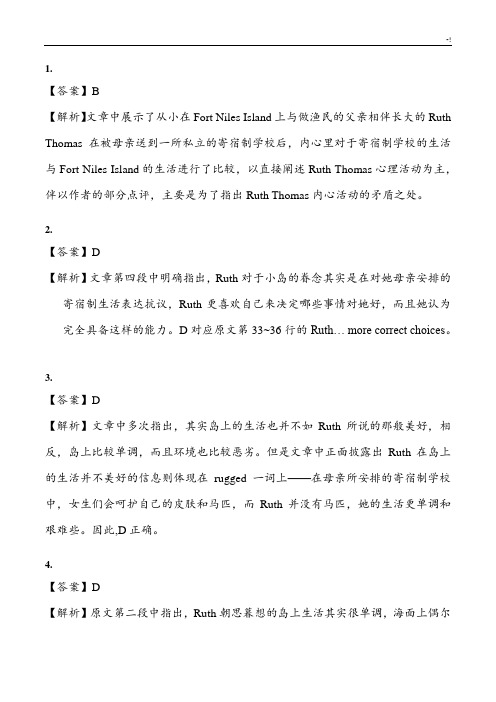
1.【答案】B【解析】文章中展示了从小在Fort Niles Island上与做渔民的父亲相伴长大的Ruth Thomas在被母亲送到一所私立的寄宿制学校后,内心里对于寄宿制学校的生活与Fort Niles Island的生活进行了比较,以直接阐述Ruth Thomas心理活动为主,伴以作者的部分点评,主要是为了指出Ruth Thomas内心活动的矛盾之处。
2.【答案】D【解析】文章第四段中明确指出,Ruth对于小岛的眷念其实是在对她母亲安排的寄宿制生活表达抗议,Ruth更喜欢自己来决定哪些事情对她好,而且她认为完全具备这样的能力。
D对应原文第33~36行的Ruth… more correct choices。
3.【答案】D【解析】文章中多次指出,其实岛上的生活也并不如Ruth所说的那般美好,相反,岛上比较单调,而且环境也比较恶劣。
但是文章中正面披露出Ruth在岛上的生活并不美好的信息则体现在rugged一词上——在母亲所安排的寄宿制学校中,女生们会呵护自己的皮肤和马匹,而Ruth并没有马匹,她的生活更单调和艰难些。
因此,D正确。
4.【答案】D【解析】原文第二段中指出,Ruth朝思暮想的岛上生活其实很单调,海面上偶尔会有seagull或seal,而且这些都是她已经比较熟悉的场景,就好像她对自己卧室的天花板那样熟悉,作者主要是为了体现出Ruth生活的单调性,因此D正确。
5.【答案】D【解析】根据文章前三段的内容来看,Ruth离开Fort Niles岛后,对岛上的生活充满了怀念,因此,这里的passion主要表现的是她对于岛上生活的喜欢及热爱,故D正确。
6.【答案】A【解析】第27~32行指出,Ruth故意表现出对小岛生活的热爱之情,主要是为了抗议她的母亲擅做主张让她进入寄宿制学校。
A是对原文中It was her resistance against… for her own good的同义转述。
2016年12月3日SAT阅读真题分析
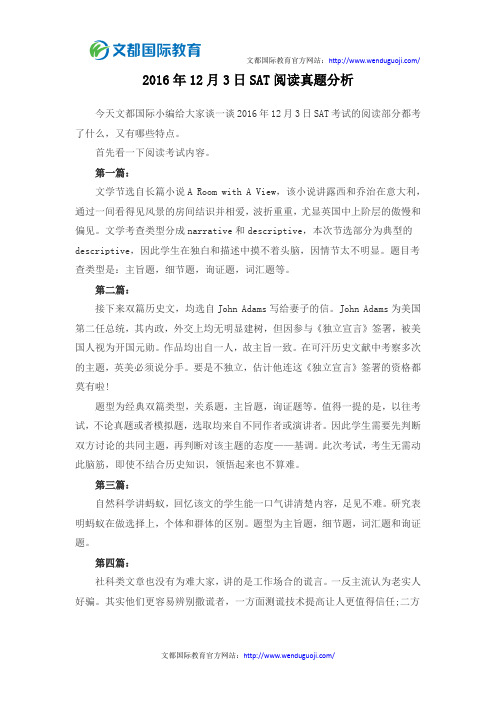
2016年12月3日SAT阅读真题分析今天文都国际小编给大家谈一谈2016年12月3日SAT考试的阅读部分都考了什么,又有哪些特点。
首先看一下阅读考试内容。
第一篇:文学节选自长篇小说A Room with A View,该小说讲露西和乔治在意大利,通过一间看得见风景的房间结识并相爱,波折重重,尤显英国中上阶层的傲慢和偏见。
文学考查类型分成narrative和descriptive,本次节选部分为典型的descriptive,因此学生在独白和描述中摸不着头脑,因情节太不明显。
题目考查类型是:主旨题,细节题,询证题,词汇题等。
第二篇:接下来双篇历史文,均选自John Adams写给妻子的信。
John Adams为美国第二任总统,其内政,外交上均无明显建树,但因参与《独立宣言》签署,被美国人视为开国元勋。
作品均出自一人,故主旨一致。
在可汗历史文献中考察多次的主题,英美必须说分手。
要是不独立,估计他连这《独立宣言》签署的资格都莫有啦!题型为经典双篇类型,关系题,主旨题,询证题等。
值得一提的是,以往考试,不论真题或者模拟题,选取均来自不同作者或演讲者。
因此学生需要先判断双方讨论的共同主题,再判断对该主题的态度——基调。
此次考试,考生无需动此脑筋,即使不结合历史知识,领悟起来也不算难。
第三篇:自然科学讲蚂蚁,回忆该文的学生能一口气讲清楚内容,足见不难。
研究表明蚂蚁在做选择上,个体和群体的区别。
题型为主旨题,细节题,词汇题和询证题。
第四篇:社科类文章也没有为难大家,讲的是工作场合的谎言。
一反主流认为老实人好骗。
其实他们更容易辨别撒谎者,一方面测谎技术提高让人更值得信任;二方面我们通过信任他人,也实现识人能力的提升。
该文一贯秉承真题图表题的简易风格,不像可汗图表题可能涉及更复杂运算。
第五篇:最后一篇自然科学文章,探讨氧气出现时间比现行认为的更迟,属于典型科研成果新颠覆旧的思维,难度不大。
以上就是小编为大家带来的2016年12月3日SAT考试的阅读部分分析,可以看出,人文社科一直是SAT阅读钟爱的出题范围,平时多扩展一下这方面的背景知识是一个非常好的阅读备考途径。
明志教育:2016年5月7日新SAT亚洲首考阅读深度解析
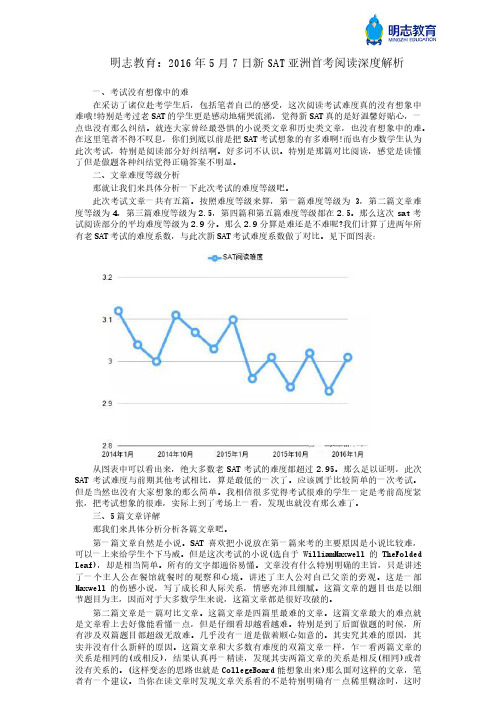
明志教育:2016年5月7日新SAT亚洲首考阅读深度解析一、考试没有想像中的难在采访了诸位赴考学生后,包括笔者自己的感受,这次阅读考试难度真的没有想象中难哦!特别是考过老SAT的学生更是感动地痛哭流涕,觉得新SAT真的是好温馨好贴心,一点也没有那么纠结。
就连大家曾经最恐惧的小说类文章和历史类文章,也没有想象中的难。
在这里笔者不得不叹息,你们到底以前是把SAT考试想象的有多难啊!而也有少数学生认为此次考试,特别是阅读部分好纠结啊。
好多词不认识。
特别是那篇对比阅读,感觉是读懂了但是做题各种纠结觉得正确答案不明显。
二、文章难度等级分析那就让我们来具体分析一下此次考试的难度等级吧。
此次考试文章一共有五篇。
按照难度等级来算,第一篇难度等级为3,第二篇文章难度等级为4,第三篇难度等级为2.5,第四篇和第五篇难度等级都在2.5。
那么这次sat考试阅读部分的平均难度等级为2.9分。
那么2.9分算是难还是不难呢?我们计算了进两年所有老SAT考试的难度系数,与此次新SAT考试难度系数做了对比。
见下面图表:从图表中可以看出来,绝大多数老SAT考试的难度都超过2.95。
那么足以证明,此次SAT考试难度与前期其他考试相比,算是最低的一次了。
应该属于比较简单的一次考试。
但是当然也没有大家想象的那么简单。
我相信很多觉得考试很难的学生一定是考前高度紧张,把考试想象的很难,实际上到了考场上一看,发现也就没有那么难了。
三、5篇文章详解那我们来具体分析分析各篇文章吧。
第一篇文章自然是小说。
SAT喜欢把小说放在第一篇来考的主要原因是小说比较难,可以一上来给学生个下马威。
但是这次考试的小说(选自于WilliamMaxwell的 TheFolded Leaf),却是相当简单。
所有的文字都通俗易懂。
文章没有什么特别明确的主旨,只是讲述了一个主人公在餐馆就餐时的观察和心境。
讲述了主人公对自己父亲的旁观。
这是一部Maxwell的伤感小说,写了成长和人际关系,情感充沛且细腻。
- 1、下载文档前请自行甄别文档内容的完整性,平台不提供额外的编辑、内容补充、找答案等附加服务。
- 2、"仅部分预览"的文档,不可在线预览部分如存在完整性等问题,可反馈申请退款(可完整预览的文档不适用该条件!)。
- 3、如文档侵犯您的权益,请联系客服反馈,我们会尽快为您处理(人工客服工作时间:9:00-18:30)。
新SAT阅读官方样题- 深度解读1在3月初公布的改革细则中,涉及到阅读部分的改革主要包含以下方面Relevant Words in Context,Command of Evidence,Analysis in Science and in Social Studies,Founding Documents and Great Global Conversation。
针对这些细则,结合第一套官方样题Sample 1,改革后的阅读部分具体分析如下:1、Analysis in Science and in Social Studies新版的SAT考试文章选材涉及的学科更为广泛。
本文节选自议员Barbara Jordan在尼克松总统的弹劾听证会上的讲话,内容是关于何时及如何弹劾总统。
尽管现有的SAT考试中有很多不同类型的文章,但是学生不会遇到关于科学和历史题材的文章。
然而在新版SAT考试的阅读部分中,学生都会遇到关于科学、历史以及社会学方面的文章,并运用在该科目的相关知识来帮助更好的分析理解文章。
此外,每次考试都会包含一篇来自建国纲领文献或由或相关的全球对话。
学生会读到一篇例如“独立宣言”,林肯的“葛底斯堡演说”这样的演讲。
2、Relevant Words in Context现有SAT考试中的词汇较为晦涩,并且考试之后很少被用到。
而新版SAT考试将摒弃生僻词汇,侧重于考察学生根据语境推断词义,考试中的词汇将是学生在大学和日后的生活中都会用到的。
但这不能说明对于词汇考察的难度一定会降低,因为在去掉生词的同时,会加强学生对于常用词用法的深入考察。
词汇考察将缩小广度,扩大深度。
例如Sample 1中的第三题:3. As used in line 37, “channeled” most nearly mea nsA) wornB) sentC) constrainedD) siphoned正确答案:C相关原文:The nature of impeachment: a narrowly channeled exception to the separation of powers maxim. The Federal Convention of 1787 said that. It limited impeachment to high crimes and misdemeanors, and di scounted and opposed the term “maladministration.”channel一词所在的句子用“narrowly channeled”来形容“exception”,纵观选项,C选项“限制”代回去较为通顺,在下一句中,speaker提出“将指控仅限于重罪,而忽视了渎职失职”,可以判断speaker在这里感到很少有被指控的情况,因此可以可以判断C为正确答案,这里指讲exception(指控)的范围限制得过窄。
尽管“channel”一词很常用,但是在此处考察的并非其常用词义,另外,为了更确切地判断“channel”在这里的用法,除了本句外还需从上下文中寻找线索,而现有的SAT阅读中的词汇题往往通过本句就能判断出答案。
因此,备考新SAT的学生将不再需要记忆艰深晦涩的词汇,为了掌握词汇的全面用法,主要通过大量阅读、精度,通过长期的积累来掌握,而且更加需要注重寻找上下文的联系。
3、Command of Evidence 使用证据改版后的基于证据的阅读和写作部分,将会要求学生展现他们对于和使用取材广泛的证据的解释、融合能力。
每一篇文章中至少会有一个问题要求学生引用原文来支持前一个问题的答案。
有些段落将搭配图表信息,并将要求学生从中整合信息来得出最佳答案。
Sample 1中的第五题就是这种类型,要求考生从文章中找到第四题的答案出处,而该答案也并不在第四题题目所给出行号的附近,而是需要跨段落寻找。
此外,第一题要求考生判断演讲者的观点立场,第二题考察学生对于修辞措辞意图的理解,第四题为细节推断题,尽管在题目中标示出行号,但与现有SAT的细节推断题相比,这道题的相关原文范围更广,更难以定位。
通过这篇文章反映出,改革后SAT阅读部分整体难度有所增加,将更侧重于文章主旨、全文逻辑的考察, 更强调学生平时阅读的质与量题目,进一步去技巧化。
增加引用原文支持答案的题目,也就是说不仅要求选出正确答案,还要到原文中找到相应依据,从而一定程度上加大了问题的难度,之前做题时常用的排除法将不再奏效。
此外,College Board越来越看重学生对于美国历史、文化传统、时政民生的关注与了解,这一领域对于国内考生来说较为陌生,从而一定程度上也增加了阅读理解的难度,建议学生尽早准备。
新SAT阅读官方样题- 深度解读2在最新SAT阅读官方样题中,我们通过从文章和题目两方面的深入解读,可以推断出官方在文章题材和文章内容方面求深求变的趋势,以及在问题方面更为注重文章结构和问题联系的特点。
在文章方面我们可以看到3个趋势:1. 自然科学文章题材的具体化在以往的SAT阅读考试中,自然科学类的文章所占的比例一直比较稳定,环境话题、物理话题、科学思想话题占据了自然科学类文章的主流。
话题偏概括化和理论化,重点经常是公众对于某自然科学话题的评价(譬如对于核能,对于物种复苏,对于生态旅行),对于某理论的概括性介绍(譬如对于弦理论,对于科学家思维方式),08年真题的海底发光生物题材和07年的猎豹基因题材是为数不多的介绍物种的文章。
但是从最新SAT的官方样题来看,阅读的自然科学类文章有着具体化的趋势,比如Sample Reading Set2的自然科学类文章,明确表明是节选自Ed Young的“Turtles Use the Earth’s Magnetic Field as Global GPS”,讨论的是海龟的定位导航功能,涉及到了非常具体的话题。
2. 自然科学文章内容的专业化文章内容则涉及到了更多地专业知识与术语,提到了科学研究的问题以及结果,科学家的研究论据和结论。
下面我们可以具体呈现以下本篇自然科学类文章的结构:Paragraph1: 引出话题-海龟如何定位Paragraph2: 解答问题-海龟用地磁场定位Paragraph3: Lohmann早期研究-动物用地磁场做指南针Paragraph4:Lohmann后续研究-动物用地磁场定位Paragraph5:Lohmann后续研究-动物用地磁场确定经度Paragraph6:延续上一段确定经度-Lohmman如何设计实验Paragraph7:以前对于动物定位导航的研究-只知存在,不知原理Paragraph8:Putman研究指出海龟定位原理-方向与强度从上面对于文章结构的分析可以看出,后六段涉及到的都是Lohmann和Putman的研究成果,尤其在第五段和第六段,提到了非常专业的如何模拟地磁场手法。
譬如在文章第40行,he tweaked his magnetic tanks to stimulate the fields in two positions with the same latitude at opposite ends of the Atlantic,文章描述了Lohmann如何修正自己模拟地磁场的技术。
3. 引入图表增加科学性在最新官方样题中,自然科学类文章的结尾出现了文章中提到过的地磁场模拟图,而且在问题中也涉及到了对于图表的解读,图表与文章内容的结合应用。
在这里SAT的阅读出现了类似ACT 阅读的倾向。
而在题目方面,可以看到3个新的特点:1. 出现在文章中有多处定位点而且需要自己定位的题目现在的SAT阅读题目中,在题干中直接给出定位行号的题目占绝大部分。
对于没有给出行号的问题,一部分是涉及到主旨,行文结构,整体态度类的全文题,另一部分通常都可以通过上下题的行号定位,而且题目出现顺序和文章顺序是一致的。
在最新官方样题中,在自然科学类文章的第一题就出现了没有行号定位的题目:The passage most strongly suggests that Adelita used which of the following to navigate her 9000-mile journey?The current of the North Atlantic gyreCues from electromagnetic coils designed by Putman and LohmannThe inc lination and intensity of Earth’s magnetic fieldA stimulated “magnetic signature” configured by Lohmann通过题干关键词Adelita可以定位到文章第一段的line1,但是通读第一段之后我们可以发现,在第一段并没有提出对于问题的解答。
因此就需要我们联系全文来解答这一题。
通过前面对于文章结构的分析我们可以看出,对于第一段提出的问题最直接的解答就是第二段line9, they can use the Earth’s magnetic field as their own GPS. 但是在文章最后一段,对于海龟如何利用地磁场这一点做了进一步的解释,在line57,Putman thinks that the turtles work out their position using two features of the Earth’s magnetic field…Putman提到了海龟是利用地磁场的两个特征来定位的,第一个特征在line59的inclination,第二个特征在line63的intensity。
综合第二段和最后一段的信息,我们可以得出,海龟Adelita是用过地磁场的方向和强度来定位的,可以对应到C选项问题之间出现联系在以往的SAT阅读考试中,题目都是独立出现的,第一题的解答通常不会影响后续的题目。
但是在最新官方样题中,在第二道问题问道了第一题与第二题之间的联系。
Which choice provides the best evidence for the answer to the previous question?Lines 1-3(“ In 1996…way”)Lines 30-32(“Using… surface”)Lines 53-55(“In the wild… stars”)Lines 64-67(“Neither… it is”)文章哪个部分能够最好的为前一题(第一题)提供答案。
如果同学们在解答第一题的时候还没有完全找到文章里的依据,那么第二题其实对我们是一个非常好的提示,我们完全可以通过第二题在选项中提供的定位点来印证第一题。
